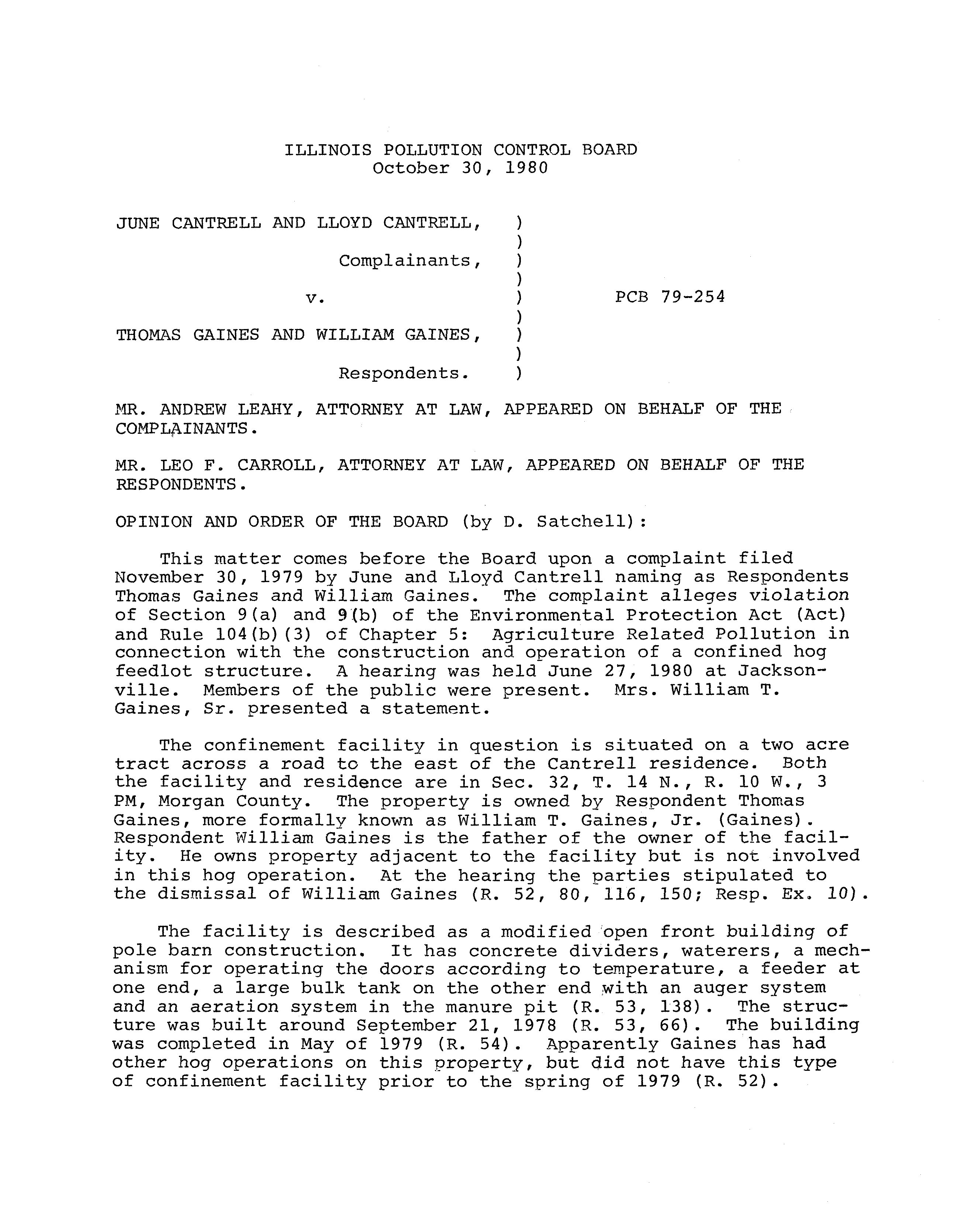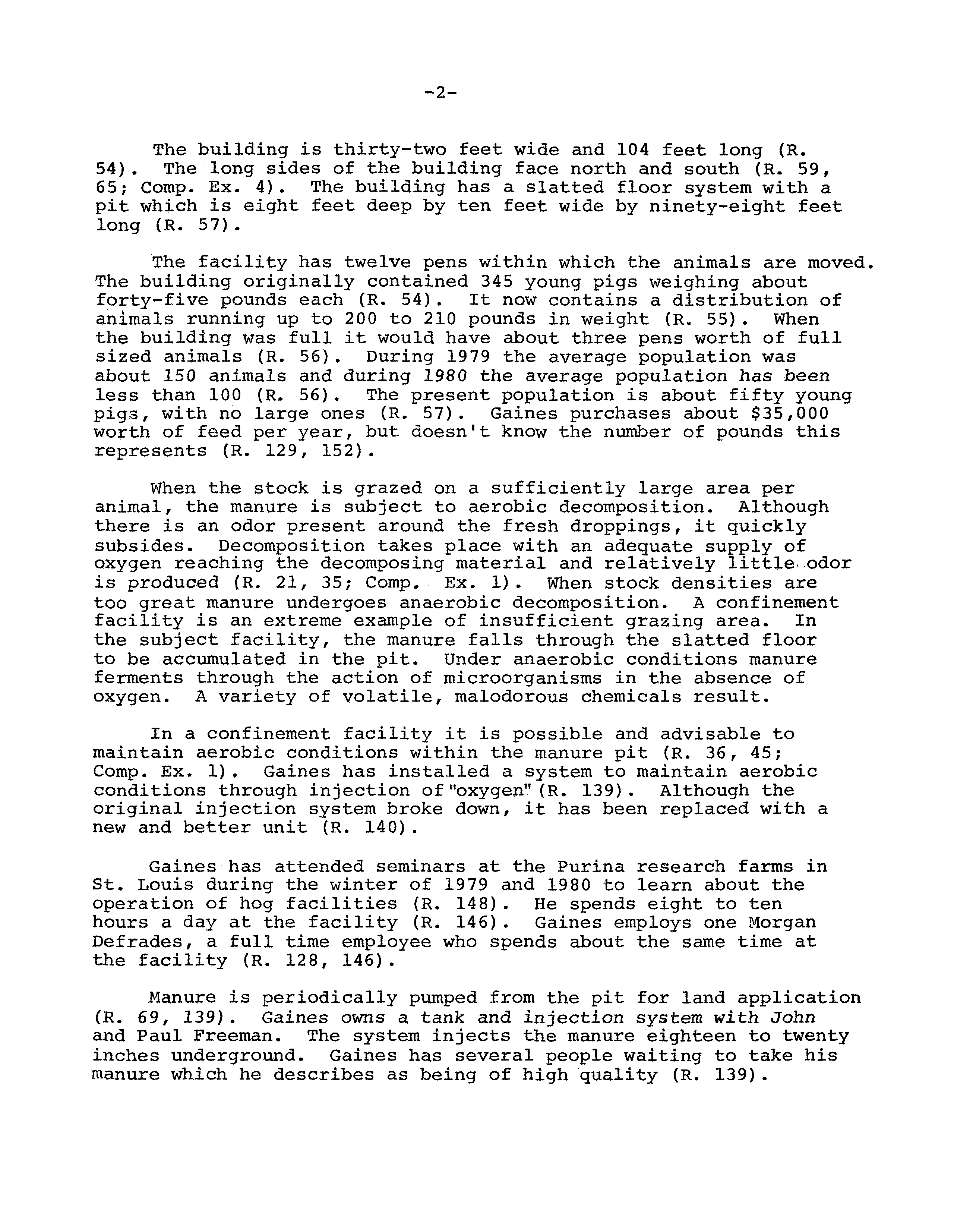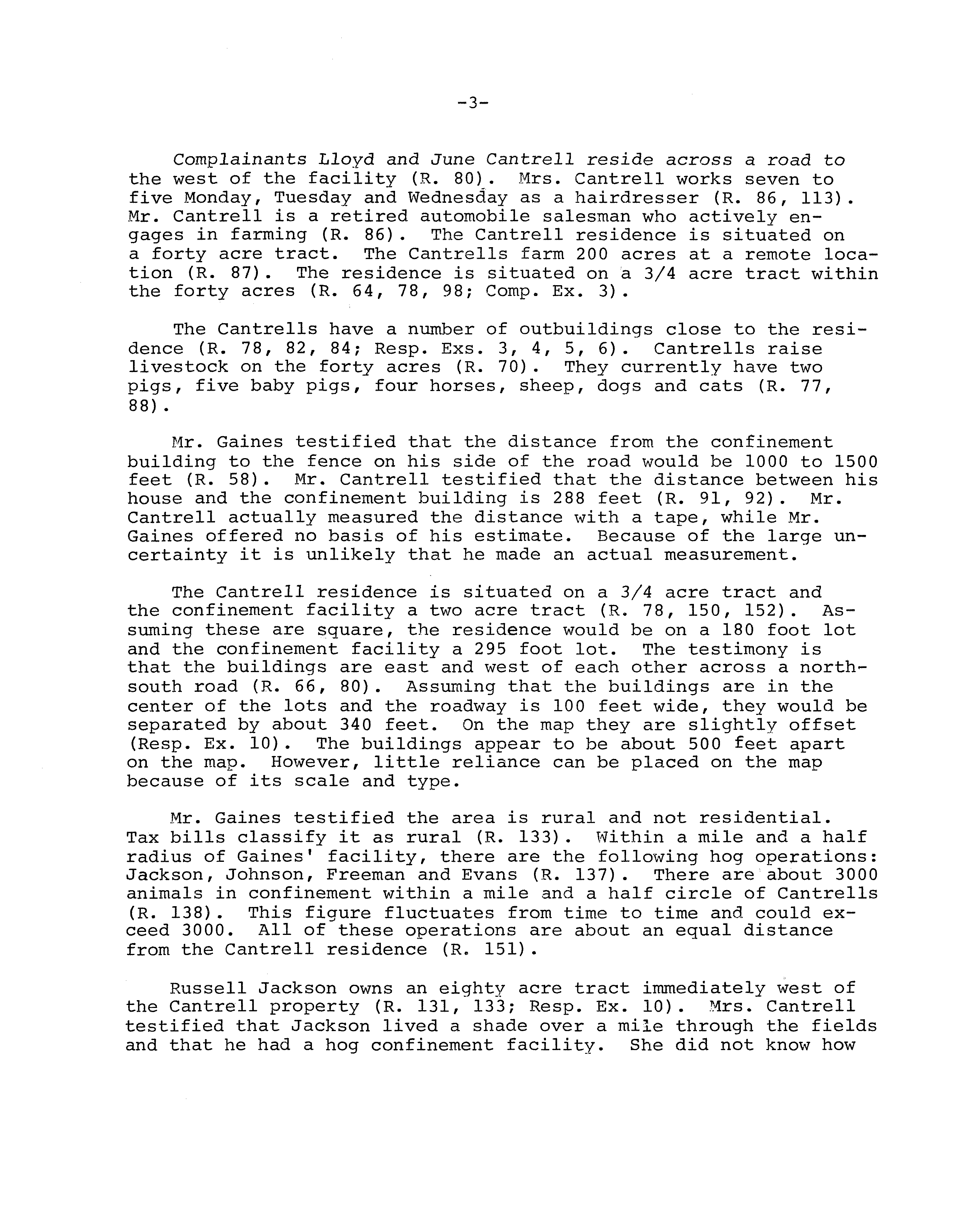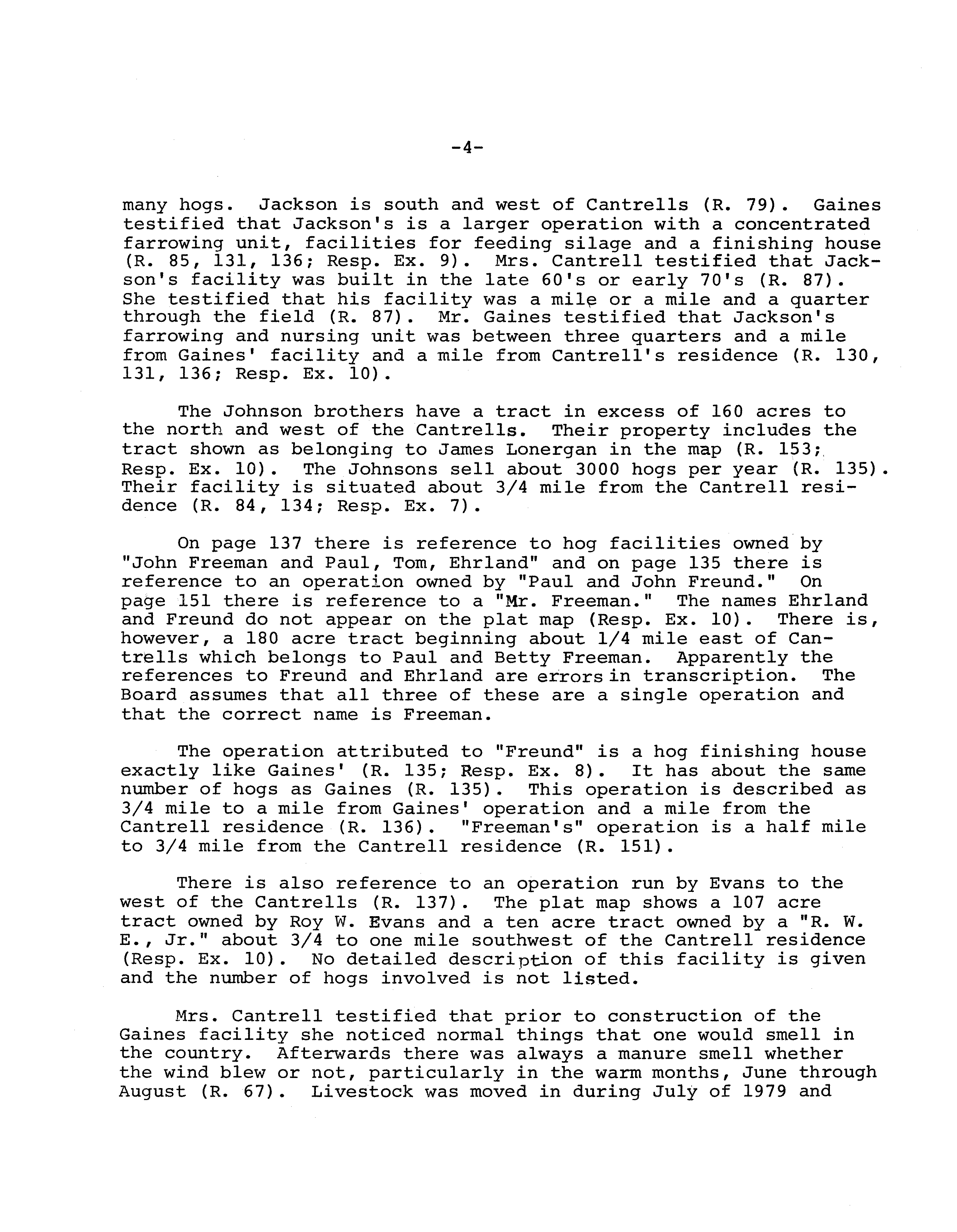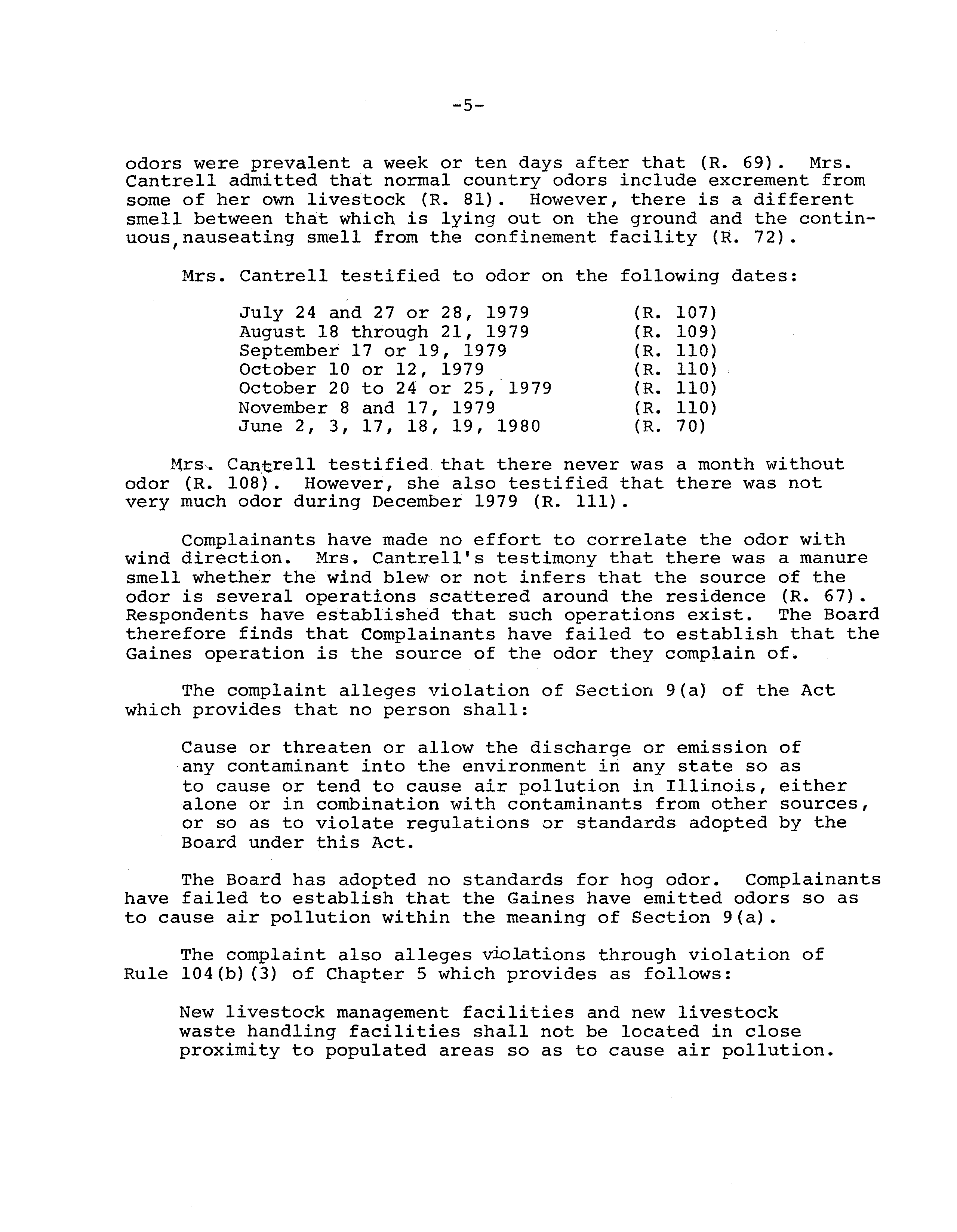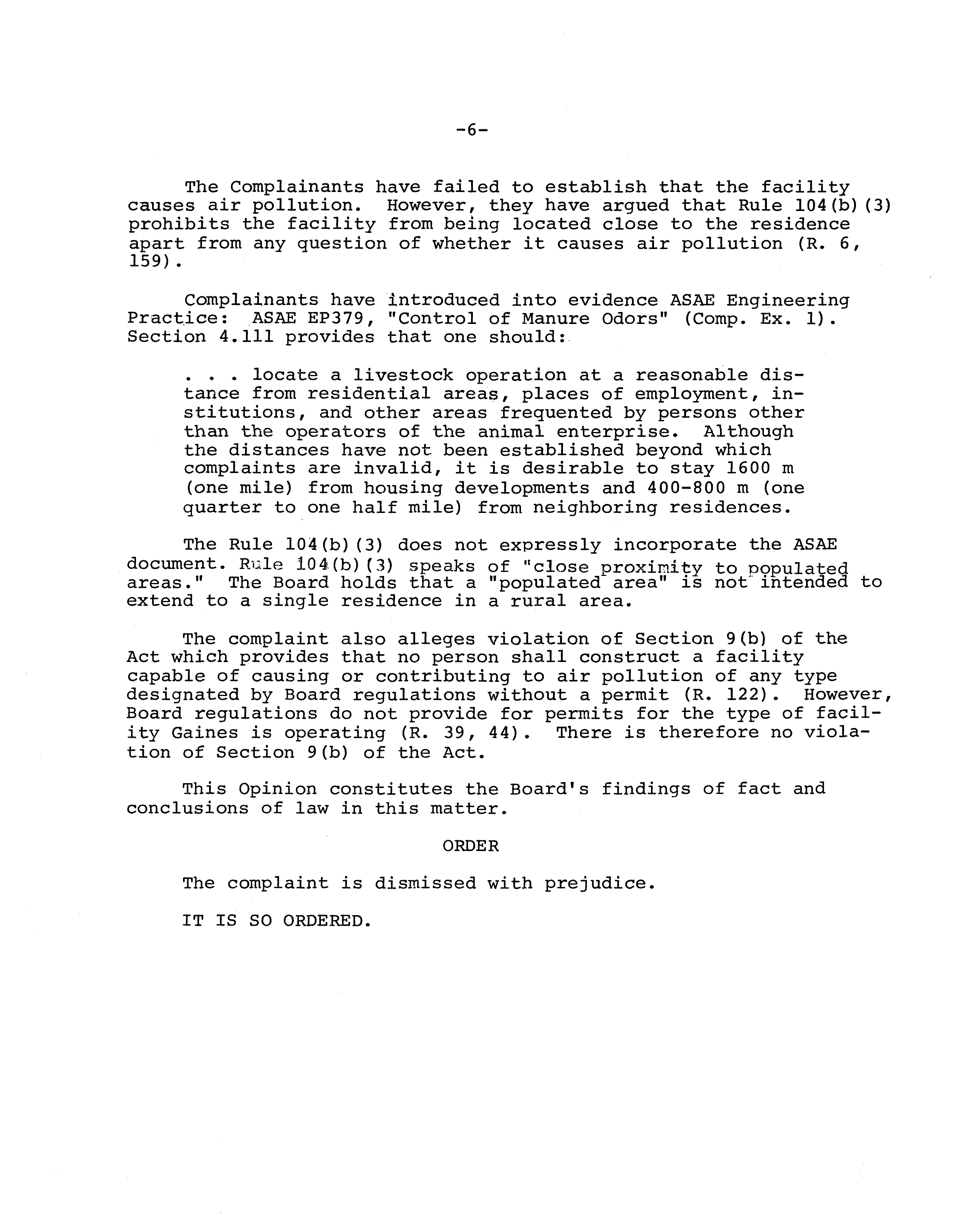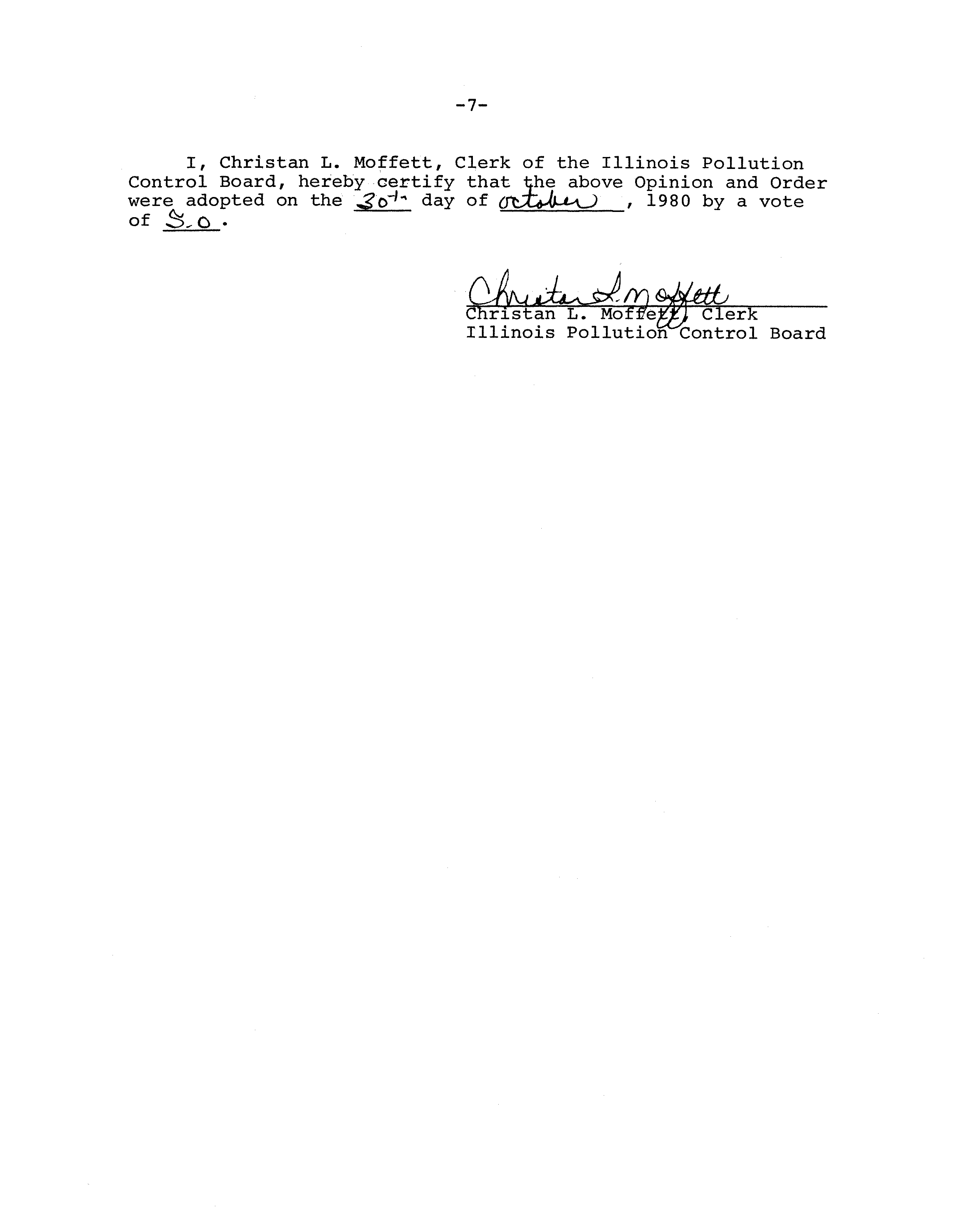ILLINOIS POLLUTION CONTROL BOARD
October 30, 1980
JUNE
CANTRELL
AND
LLOYD
CANTRELL,
)
Complainants,
v.
)
PCB
79—254
THOMAS
GAINES
AND
WILLIAM
GAINES,
)
Respondents.
MR.
ANDREW
LEAHY,
ATTORNEY
AT
LAW,
APPEARED
ON
BEHALF
OF
THE
COMPLAINANTS.
MR.
LEO
F.
CARROLL,
ATTORNEY
AT
LAW,
APPEARED
ON
BEHALF
OF
THE
RESPONDENTS.
OPINION
AND
ORDER OF THE BOARD
(by D.
Satchell):
This matter comes before the Board upon a complaint filed
November 30,
1979 by June and Lloyd Cantrell naming
as Respondents
Thomas Gaines and William Gaines.
The complaint alleges violation
of Section 9(a)
and 9(b)
of the Environmental Protection Act
(Act)
and Rule 104(b) (3)
of Chapter 5:
Agriculture Related Pollution in
connection with the construction and operation of a confined hog
feedlot structure.
A hearing was held June 27,
1980 at Jackson-
ville.
Members of the public were present.
Mrs. William T.
Gaines,
Sr. presented a statement.
The confinement facility in question is situated on a two acre
tract across
a road to the east of the Cantrell residence.
Both
the facility and residence are in Sec.
32,
T.
14 N., R.
10 W.,
3
PM, Morgan County.
The property is owned by Respondent Thomas
Gaines, more formally known as William T.
Gaines,
Jr.
(Gaines).
Respondent William Gaines is the father of the owner of the facil-
ity.
He owns property adjacent to the facility but is not involved
in this hog operation.
At the hearing the parties stipulated to
the dismissal of William Gaines
(R.
52,
80,
116, 150;
Resp. Ex.
10).
The facility is described as
a modified open front building of
pole barn construction.
It has concrete dividers, waterers,
a mech-
anism for operating the doors according to temperature,
a feeder at
one end,
a large bulk tank on the other end with an auger system
and an aeration system in the manure pit
(R.
53,
138).
The struc-
ture was built around September 21, 1978
(R.
53, 66).
The building
was completed in May of 1979
(R. 54).
Apparently Gaines has had
other hog operations on this property, but ~id not have this type
of confinement facility prior to the spring of 1979
(R.
52).
—2—
The building is thirty-two feet wide and 104 feet long
(R.
54).
The long sides of the building face north and south
(R.
59,
65; Comp.
Ex.
4).
The building has a slatted floor system with a
pit which is eight feet deep by ten feet wide by ninety-eight feet
long
(R.
57).
The facility has twelve pens within which the animals are moved.
The building originally contained 345 young pigs weighing about
forty—five pounds each
(R.
54).
It now contains
a distribution of
animals running up to 200 to 210 pounds in weight
(R. 55).
When
the building was full it would have about three pens worth of full
sized animals
(R. 56).
During 1979 the average population was
about 150 animals and during 1980 the average population has been
less than 100
(R.
56).
The present population is about fifty young
pigs, with no large ones
(R.
57).
Gaines purchases about $35,000
worth of feed per year, but doesn’t know the number of pounds this
represents
(R.
129, 152).
When the stock is grazed on a sufficiently large area per
animal,
the manure is subject to aerobic decomposition.
Although
there is an odor present around the fresh droppings,
it quickly
subsides.
Decomposition takes place with an adequate supply of
oxygen reaching the decomposing material and relatively little ~odor
is produced
(R.
21,
35;
Comp.
Ex.
1).
When stock densities are
too great manure undergoes anaerobic decomposition.
A confinement
facility is an extreme example of insufficient grazing area.
In
the subject facility, the manure falls through the slatted floor
to be accumulated in the pit.
Under anaerobic conditions manure
ferments through the action of microorganisms in the absence of
oxygen.
A variety of volatile, malodorous chemicals result.
In a confinement facility it is possible and advisable to
maintain aerobic conditions within the manure pit
(R.
36, 45;
Comp.
Ex.
1).
Gaines has installed a system to maintain aerobic
conditions through injection of “oxygen” (R.
139).
Although the
original injection system broke down,
it has been replaced with a
new and better unit
(R.
140).
Gaines has attended seminars at the Purina research farms in
St.
Louis during the winter of 1979 and 1980 to learn about the
operation of hog facilities
(R.
148).
He spends eight to ten
hours
a day at the facility
(R.
146).
Gaines employs one Morgan
Defrades,
a full time employee who spends about the same time at
the facility
(R.
128,
146).
Manure is periodically pumped from the pit for land application
(R.
69,
139).
Gaines owns a tank and Injection system with John
and Paul Freeman.
The system injects the manure eighteen to twenty
inches underground.
Gaines has several people waiting to take his
manure which he describes as being of high quality
(R.
139).
—3—
Complainants Lloyd and June Cantrell reside across a road to
the west of the facility
CR.
80).
Mrs. Cantrell works seven to
five Monday, Tuesday and Wednesday as
a hairdresser
(R.
86, 113).
Mr. Cantrell is
a retired automobile salesman who actively en-
gages in farming
CR.
86).
The Cantrell residence is situated on
a forty acre tract.
The Cantrells
farm
200 acres
at a remote loca-
tion
CR.
87).
The residence is situated on a 3/4 acre tract within
the forty acres
CR.
64,
78,
98; Comp.
Ex.
3).
The Cantrells have a number of outbuildings close to the resi-
dence
CR.
78,
82,
84; Resp. Exs.
3,
4,
5,
6)
.
Cantrells raise
livestock on the forty acres
(R.
70).
They currently have two
pigs,
five baby pigs,
four horses, sheep, dogs and cats
CR.
77,
88)
Mr.
Gaines testified that the distance from the confinement
building to the fence on his side of
the
road
would
be
1000 to 1500
feet
CR.
58).
Mr. Cantrell testified that the distance between his
house and the confinement building is 288
feet
(R.
91,
92).
Mr.
Cantrell actually measured the distance with a tape, while Mr.
Gaines
offered no basis of his estimate.
Because of the large un-
certainty it is unlikely that he made an actual measurement.
The Cantrell residence is situated on a 3/4 acre tract and
the confinement facility
a two acre tract
CR.
78,
150,
152).
As-
suming these are square, the residence would be on
a 180 foot lot
and the confinement facility a 295 foot lot.
The testimony is
that the buildings are east and west of each other across a north-
south road
(R.
66,
80).
Assuming that the buildings are in the
center of the lots and the roadway is 100 feet wide, they would be
separated by about 340 feet.
On the map they are slightly offset
(Resp.
Ex. 10).
The buildings appear to he about 500 feet apart
on the map.
However,
little reliance can be placed on the map
because of its scale and type.
Mr.
Gaines
testified
the
area is rural and not residential.
Tax
bills
classify
it
as
rural
CR.
133).
Within
a
mile
and
a
half
radius of Gaines’
facility, there are the following hog operations:
Jackson, Johnson, Freeman and Evans
CR.
137)
.
There are about 3000
animals in confinement within a mile and a half circle of Cantrells
CR. 138).
This figure fluctuates from time to time and could ex-
ceed 3000.
All of these operations are about an equal distance
from the Cantrell residence
CR. 151).
Russell Jackson owns an eighty acre tract immediately west of
the Cantrell property
CR.
131,
133;
Resp.
Ex.
10).
Mrs. Cantrell
testified that Jackson lived a shade over a mile through the fields
and that he had
a hog confinement facility.
She did not know how
—4—
many hogs.
Jackson is south and west of Cantrells
(R.
79).
Gaines
testified that Jackson’s
is a larger operation with a concentrated
farrowing unit, facilities for feeding silage and a finishing house
CR.
85, 131,
136; Resp.
Ex.
9).
Mrs. Cantrell testified that Jack-
son’s facility was built in the late 60’s or early 70’s
(R.
87).
She testified that his facility was
a mile or a mile and a quarter
through the field
CR.
87).
Mr. Gaines testified that Jackson’s
farrowing and nursing unit was between three quarters and a mile
from Gaines’ facility and a mile from Cantrell’s residence
(R.
130,
131, 136; Resp.
Ex.
10).
The Johnson brothers have a tract in excess of 160 acres to
the north and west of the Cantrells.
Their property includes the
tract shown as belonging to James Lonergan in the map
(R.
153;,
Resp.
Ex.
10).
The Johnsons sell about 3000 hogs per year
CR.
135).
Their facility is situated about 3/4 mile from the Cantrell resi-
dence
CR.
84, 134; Resp.
Ex.
7).
On page 137 there is reference to hog facilities owned by
“John Freeman and Paul,
Tom, Ehrland” and on page 135 there is
reference to an operation owned by “Paul and John Freund.”
On
page 151 there is reference to a “Mr. Freeman.”
The names Ehrland
and Freund do not appear on the plat map
(Resp.
Ex.
10).
There is,
however,
a 180 acre tract beginning about 1/4 mile east of Can—
trells which belongs to Paul and Betty Freeman.
Apparently the
references to Freund and Ehrland are errors in transcription.
The
Board assumes that all three of these are
a single operation and
that the correct name is Freeman.
The operation attributed to “Freund” is a hog finishing house
exactly like Gaines’
CR.
135;
Resp.
Ex.
8).
It has about the same
number of hogs as Gaines
CR.
135).
This operation is described as
3/4 mile to a mile from Gaines’ operation and a mile from the
Cantrell residence
(R.
136).
“Freeman’s” operation is a half mile
to 3/4 mile from the Cantrell residence
CR.
151).
There is also reference to an operation run by Evans to the
west of the Cantrells
CR.
137).
The plat map shows a 107 acre
tract owned by Roy W. Evans and a ten acre tract owned by a
“R.
W.
E., Jr.” about 3/4 to one mile southwest of the Cantrell residence
CResp. Ex.
10).
No detailed description of this facility is given
and the number of hogs involved is not listed.
Mrs. Cantrell testified that prior to construction of the
Gaines facility she noticed normal things that one would smell in
the country.
Afterwards there was always a manure smell whether
the wind blew or not, particularly in the warm months, June through
August
CR.
67).
Livestock was moved in during July of 1979 and
—5—
odors
were
prevalent
a
week
or
ten
days
after
that
CR.
69).
Mrs.
Cantrell
admitted
that
normal
country
odors
include
excrement
from
some
of
her
own
livestock
(R.
81).
However,
there
is
a
different
smell
between
that
which
is
lying
out
on
the
ground
and
the
contin-
uous,nauseating smell from the confinement facility
(R. 72).
Mrs. Cantrell testified to odor on the following dates:
July 24 and 27 or 28, 1979
CR.
107)
August 18 through 21, 1979
CR.
109)
September 17 or 19,
1979
CR.
110)
October
10 or 12,
1979
CR.
110)
October 20 to 24 or 25,
1979
CR.
110)
November
8 and 17,
1979
CR.
110)
June 2,
3,
17,
18, 19,
1980
(R.
70)
Mrs. Cantrell testified that there never was a month without
odor
(R. 108).
However,
she also testified that there was not
very much odor during December 1979
CR.
111).
Complainants have made no effort to correlate the odor with
wind direction.
Mrs. Cantrell’s testimony that there was a manure
smell whether the wind blew or not infers that the source of the
odor is several operations scattered around the residence
(R.
67).
Respondents have established that such operations
exist.
The Board
therefore finds that Complainants have failed to establish that the
Gaines operation is the source of the odor they complain of.
The complaint alleges violation of Section 9Ca)
of the Act
which provides that no person shall:
Cause or threaten or allow the discharge or emission of
any contaminant into the environment in any state so as
to cause or tend to cause air pollution in Illinois, either
alone or in combination with contaminants from other sources,
or so as to violate regulations or standards adopted by the
Board under this Act.
The Board has adopted no standards for hog odor.
Complainants
have failed to establish that the Gaines have emitted odors so as
to cause air pollution within the meaning of Section 9Ca).
The complaint also alleges violations through violation of
Rule 104(b) (3)
of Chapter
5 which provides
as follows:
New livestock management facilities and new livestock
waste handling facilities shall not be located in close
proximity to populated areas so as to cause air pollution.
—6—
The Complainants have failed to establish that the facility
causes air pollution.
However, they have argued that Rule 104(b) (3)
prohibits the facility from being located close to the residence
apart from any question of whether it causes air pollution
CR.
6,
159)
Complainants have introduced into evidence ASAE Engineering
Practice:
ASAE
EP379,
“Control of Manure Odors”
(Comp.
Ex.
1).
Section 4.111 provides that one should:
locate a livestock operation at a reasonable dis-
tance from residential areas, places of employment, in-
stitutions, and other areas frequented by persons other
than the operators of the animal enterprise.
Although
the distances have not been established beyond which
complaints are invalid, it is desirable to stay 1600 m
Cone mile)
from housing developments and 400—800 m
Cone
quarter to one half mile)
from neighboring residences.
The Rule 104(b) (3)
does not expressly incorporate the ASAE
document. Rule 104Cb) (3)
speaks of “close proximity to populated
areas.”
The Board holds that a “populated area”
is not~intended to
extend to a single residence in a rural area.
The complaint also alleges violation of Section 9(b)
of the
Act which provides that no person shall construct a facility
capable of causing or contributing to air pollution of any type
designated by Board regulations without a permit
CR.
122).
However,
Board regulations do not provide for permits for the type of facil-
ity Gaines is operating
CR.
39,
44).
There
is therefore no viola-
tion of Section 9(b) of the Act.
This Opinion constitutes the Board’s findings of fact and
conclusions of law in this matter.
ORDER
The complaint is dismissed with prejudice.
IT
IS
SO
ORDERED.
—7—
I, Christan L. Moffett, Clerk of the Illinois Pollution
Control Board, hereby certify that
he above Opinion and Order
were adopted on the
.3o~
day of
___________,
1980 by a vote
of
~
ristan L. Moffe~)Clerk
Illinois Pollution Control Board
